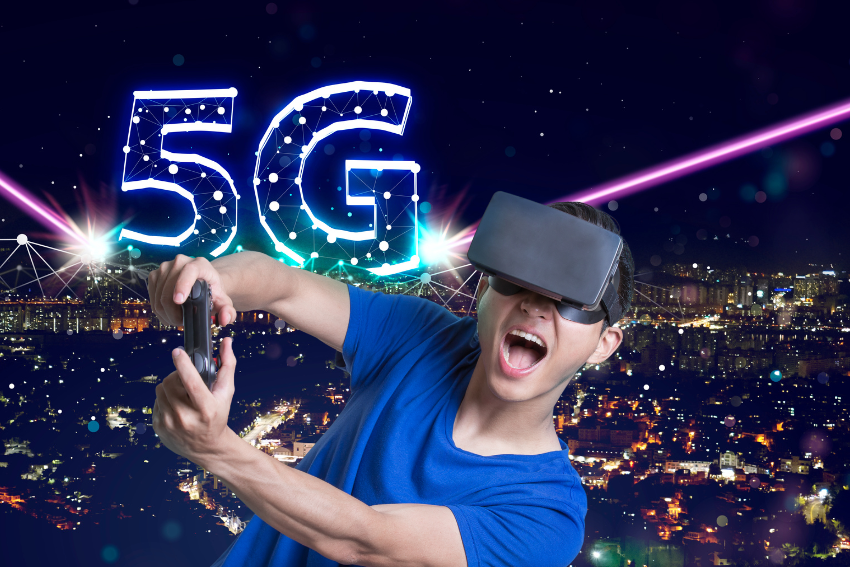Introduction 5G and VR Gaming
VR gaming has transformed the entertainment sector as it involves gamers in photorealistic immersive and interactive virtual worlds. Still, VR immersion has been restricted due to technology, especially relative to network performance. The wait is over and the future is here with the advent of 5G technology promising lightning speed connections, high bandwidth and a large number of devices per second, VR gaming on the other hand is soon going to be revolutionary.

This article explores how 5G enhances VR gaming, addressing its technical advantages, current applications, challenges, and future potential.
What is 5G?
The 5G or the fifth generation of wireless networks will be much improved relative to previous versions. Major characteristics are:
- High Bandwidth: The 5G technology has the capability of providing data at high speed, which is 10 Gbps, thus making the streaming of high-resolution content easy.
- Ultra-Low Latency: Being accompanied by 1 millisecond latency, 5G will guarantee that the transfer of data is as fast as possible and is required for live interactions.
- Massive Connectivity: 5G will enable up to 1 million connections per one square kilometer that will be able to access multiplayer virtual reality scenes.
- Network Slicing: This is so that networks can be configured to serve particular applications, and by doing so the VR gaming performance will be to its maximum.
VR Gaming Requirements
VR games require powerful technical proficiencies so as to provide immersive games:
- High-Resolution Graphics: VR needs 4K or more resolution per eye and per-eye resolution to produce real-time graphics, which will need tremendous amounts of data throughput.
- Low Latency: Latency must be at least 20 milliseconds, otherwise it will either give motion sickness or will break gameplay.
- Stable connectivity: Reliable network performance is a must related to multi-player games and cloud rendering.
- High Processing Power: It may be necessary to handle complicated VR environment using high-end devices, and 5G can liberate the load onto the cloud.
How 5G Enhances VR Gaming
Cloud-Based VR Gaming
In all intents and purposes, the VR games traditionally depended on the local hardware power, i.e. the high-end PCs or consoles would be used to render the complex graphics. With the 5G, the VR games can be hosted and rendered remotely, in the cloud, and streamed to the corresponding VR headset. There are a number of advantages of this:
- Reduced Hardware Costs: The heavy lifting of the computing processes is done in the cloud, which means that players can use cheap and low-weighted headsets.
- Access to High-End Experiences: Cloud gaming levels the playing fields to offer players the possibility to play on high-end games without paying exorbitant amounts of money on equipment.
- Scalability: developers can deploy the games on the server-side and thus the players always see up-to-date versions without requiring local updates.
A case in point includes services such as NVIDIA GeForce Now which relies on 5G to stream games optimized to work with VR headsets to smaller devices such as the Meta Quest, bypassing the need to locally host processing power.
Ultra-Low Latency for Seamless Interaction
The problem is that latency can be considered the enemy of VR immersion. Even 20 milliseconds of latency can make you lose the immersion or fall into lag. 5G will only have 1-5 milliseconds of latency and will allow one to respond in nearly no time:
- Real-Time Multiplayer: VR-enabled players can participate in high-paced competitive games in real-time like Beat Saber or Population: One with no apparent latency.
- Nature Interactions: More accurate headset, controller and even body tracking is a lot more realistic.
- Haptic Feedback: More complex haptic two-way communication devices, like VR gloves, need there to be minimal latency when connecting the touch with what is happening in the game. This happens with 5G.
Enhanced Multiplayer and Social VR
The large-scale multiplayer VR can be achieved with the support of 5G in terms of device connectivity on a massive scale. VRChat or Rec Room are social VR platforms that support thousands of players playing together and forming a colorful virtual community. With 5G:
- Massive Multiplayer Worlds: VR gaming will be able to hold hundreds of users in one game at a time, with easy interactions between all of them.
- Dynamic Environments: Real time stream of data enables dynamic game worlds that change based on the actions of the player.
- Cross-Platform Play: 5G has a wide bandwidth, which facilitates cross-platform compatibility allowing users to play with each other in the same VR world even though they are using different devices.
Mobile and Untethered VR
Non-emerging VR systems frequently needed wired interconnections to PCs and thereby inhibited these technologies in free movement. 5G allows a fully-wired remote, cordless VR headset, supplying:
- Freedom of Movement: The fact that the players are able to move freely without cables also increases immersion and safety.
- Location-Based VR: 5G can be used to provide outdoor virtual reality (VR) shows, including location-based entertainment in a theme park or in an urban playground.
- Portability: The 5G-powered lightweight headsets can be connected to any place within a network-covered area; therefore, VR gaming can become much more accessible.
An example is the companies such as HTC Vive, which is working on the issue of 5G-enabled headsets that directly tap into the cloud servers and avoid the need to do any local processing.
Improved Visual Fidelity
VR requires very high-resolution graphics so it is not pixelated, and immersive; 5G high bandwidth supports:
- 4K and 8K Streaming: The gamers can enjoy the advanced high-definition graphics without non-local rendering and load on the hardware.
- Foveated Rendering: This method (only part that should be rendered in high detail is rendered in high detail) works better with low-latency of 5G, since eye-tracking data is able to be processed nearly in real-time.
- Dynamic Content Delivery: 5G allows adaptive streaming, adapting and modifying the visual quality in response to the network conditions and thus ensuring a smooth operation.
Current Applications and Case Studies
A number of companies and platforms already do use 5G to power VR gaming:
- Verizon and Meta: Verizon and Meta joined forces to test out VR experiences powered by 5G on the Meta Quest, emphasizing on both cloud gaming and social VR platforms.
- Qualcomm Xr Platform: Qualcomm Snapdragon XR2, powered by the 5G-affordable VR-use headsets, present hardware in a pair of the Oculus Quest 2.
- CloudVR in China: The Chinese telecom teams such as Huawei are implementing 5G-enabled CloudVR systems that enable users to stream VR to the accessible headsets.
Such projects show how the 5G solution can facilitate and enhance VR gaming.
Challenges and Limitations
Although it is projected to be successful, 5G in VR gaming has various challenges:
Coverage: still limited by the roll out of 5G infrastructure, there may still be rural regions that simply do not have the bandwidth to invest in VR.
Deployment Cost: Deployment of 5G networks and development of VR hardware that is compatible is also an expensive affair.
Battery Life: Streaming VR content in high quality at 5G could also cause the headset battery to run out of power very fast, so power efficiency would have to be improved.
Privacy and Security: Cloud-based VR gaming is concerned with privacy of data since user movements and interactions are made over the networks.
Compatibility: Not every VR headset will work with 5G, and the handsets released several years ago can have trouble utilizing the technology to the fullest extent.
The Future of 5G and VR Gaming
The 5G intersection will shape up with VR games and create new opportunities:
- Augmented Reality (AR) Integration: 5G will integrate the AR/VR game-changing experiences on top of each other, where virtual and real-life aspects can be mixed together, so games like Pokemon GO are on steroids.
- AI-Driven Worlds: With 5G and AI, creators can make an adaptive and intelligent VR world that reshapes itself depending on the actions of the gamer.
- Holographic Displays: Holographic VR environments might become possible on the future 5G networks, as the players might be able to interact with 3D imagery in the real space.
- Global VR Esports: The low latency and connectivity of 5G will drive competitive VR esports where people all over the world can play against each other, and the tournaments will be broadcasted in real-time.
Conclusion
5G opens up all new possibilities in VR gaming, introducing it to new degrees of immersion, accessibility, and interaction. 5G can mitigate most of the limitations of VR that manifest themselves primarily in the form of latency issues, cloud-based rendering ability, ultra-low latency of the network, and widespread multiplayer support.
Although some of it, such as network coverage and battery life, is still problematic, continuing improvements on the infrastructure side and the hardware front are leading to an existential state where playing VR games will be unrestricted and immersive and accessible to all.
With the growth of 5G networks and the development of VR technology, the border between the virtual and the real is only placed under a veil as the world of a new stage of gaming breaks.



